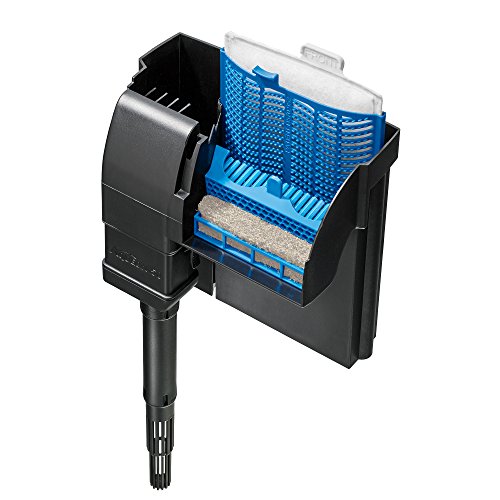The reason for adding a filter to the fish tank is to get rid of toxins, odors and discoloration in water, including nitrates and ammonia. We also need to add oxygen to the water.
It’s important to have a clear understanding; so if you’re a beginner we’ve explained the role of filtration for you under these headings.
What is filtration?
What do water filters do?
Why buy a fish tank filter?
Types of filters
Best small aquarium filter
What is filtration?
‘The general cleansing process of a contained body of water.’
In nature filtration is accomplished in several ways. For example in a body of water the current will steadily carry unwanted materials downstream. Large amounts of other life forms occupying the waters also help ensure lakes and rivers remain clean.
Unlike natural waters, a fish tank or pond is smaller in size and has no means to rid itself of unwanted materials and chemicals. Filters do this job.
What do aquarium water filters do?
Effective water filters remove excess ammonia, nitrates and dirt and maintain a healthy, aerated environment in the tank.
It’s vital to goldfish care and their life expectancy and shouldn’t be neglected. Water needs to be kept free of toxins and clear.
If you can’t see your fish because of the poor condition of the water, then it’s just a matter of time before your fish will start struggling. At best you’ll be dealing with sick fish and nursing them back to health. If they make it!
There are basically 2 types of unwanted material found in a body of contained water.
- Material tiny enough to pass through pre-filters.
- Unwanted material that has the ability to pass through any filter medium because it’s soluble in water. These water soluble materials include such things as gases and chemical compounds.
Why should I buy a fish tank filter?
Too much dirt can be the cause of death for fish. Reduced oxygen inside the fish tank along with excess nitrates and ammonia suffocate fish.
Poor water condition causes frequent changes to the water temperature which leads to other physical problems for your fish. These may not be immediately apparent.
Colorful aquariums make a room look more vivid and lively, but as you know it’s more important to maintain the aquarium to keep your fish in good health.
By ‘maintaining’ we generally don’t mean simply cleaning the aquarium, but feeding the fish properly and preserving the environment in a way that’s fit for the fish to live in.
Some people may already know what’s required, but for beginners you should buy a kit that provides the right set up for the wellbeing of your fish. It shows that you care!
When foreign substances accumulate on the tank walls, scrapers are used to remove it during water changes and then the filters can do their job.
(Tip: Introducing some algae eaters into your tank will help with algae control. Don’t be fooled though, these don’t take the place of a filter, just very handy ‘workers’ in the tank.)
Types of filters
Aquarium filters are classed according to the function they perform.
Some of the useful fish tank filters are gravel filters, air powered filters, internally powered head filters. Choice depends on the type of fish kept in the tank, size etc.
- Sponge filters are the best choice for betta fish. Bettas don’t like movement in the water.
- Also a good choice for a tank with fry. Sponge filters produce very little current and there’s a reduced risk of drawing fry into the filter system.
These are situations where air power filters are not ideal because they disturb the layer of gravel on the bottom of the tank. This disturbance throws up a lot of dirt which can quickly overload the filter.
For goldfish Aqueon filters are cheap to buy, and they work. Because the filter pump is submersed in the aquarium, there’s no need for priming at setup or when restarting the filter after cleaning or power interruptions.
There’s a number of aquarium accessories that are extremely important and aquarium filters play a vital role in maintaining a healthy aquarium so your fish can thrive.
Which will I need?
To decide which type and size filter will cope with your needs, you need to
- relate the filter system to the amount of unwanted materials and garbage that the system will have to cope with
- understand the system you use will directly affect the level of pollution found in a tank or pond.
Power filter
When looking at filters you’ll come across some complex filter systems. If you boil down their complexity basically, in principle, they all do exactly the same thing.
They’re external units that are easy to install.
If an aquarium is stocked with a larger number of fish, a more powerful and complex system is needed than if you were only housing 2 or 3 goldfish for example.
Aqueon power filters were designed with your goldfish or fish in general as well as the aquarist in mind. They have a 4 stage advanced filtration system, which includes:
Stage 1 – Dense floss removes particles and debris
Stage 2 – Activated carbon removes toxins, odors and discoloration
Stage 3 – Patented Bio-holster removes toxic ammonia and nitrites
Stage 4 – Diffuser grid removes additional toxins while adding oxygen for more active fish.
It also reduces splashing making the return quiet.



